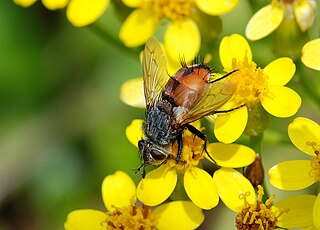
The Integrated Taxonomic Information System (ITIS) is an American partnership of federal agencies designed to provide consistent and reliable information on the taxonomy of biological species. ITIS was originally formed in 1996 as an interagency group within the US federal government, involving several US federal agencies, and has now become an international body, with Canadian and Mexican government agencies participating. The database draws from a large community of taxonomic experts. Primary content staff are housed at the Smithsonian National Museum of Natural History and IT services are provided by a US Geological Survey facility in Denver. The primary focus of ITIS is North American species, but many biological groups exist worldwide and ITIS collaborates with other agencies to increase its global coverage.

The Brachycera are a suborder of the order Diptera. It is a major suborder consisting of around 120 families. Their most distinguishing characteristic is reduced antenna segmentation.
The Dani or Baliem Valley languages are a family of clearly related Trans–New Guinea languages spoken by the Dani and related peoples in the Baliem Valley in the Highland Papua, Indonesia. Foley (2003) considers their Trans–New Guinea language group status to be established. They may be most closely related to the languages of Paniai Lakes, but this is not yet clear. Capell (1962) had posited that their closest relatives were the Kwerba languages, which Ross (2005) rejects.

The Engan, or more precisely Enga – Southern Highland, languages are a small family of Papuan languages of the highlands of Papua New Guinea. The two branches of the family are rather distantly related, but were connected by Franklin and Voorhoeve (1973).

Endomychidae, or handsome fungus beetles, is a family of beetles with representatives found in all biogeographic realms. There are around 120 genera and 1300 species. The family was established based on the type genus Endomychus, a genus erected in 1795 by Panzer which was applied to a species that Linnaeus called Chrysomela coccinea. As the common name suggests, Endomychidae feed on fungi. Crowson, in his influential treatment of the beetles, placed the family within the Cucujoidea. They have a tarsal formal of 4-4-4 or 3-3-3 and the wings lack a closed radial cell. The second antennal segment has a sensory appendage that is as long as the third antennal segment. The family has also been grouped with the Coccinellidae in a group called the Trimera for having pseudotrimerous tarsi. A 2015 molecular phylogeny study found that the Cucujoidea were found to be non-monophyletic and the Endomychidae was refined with the removal of the Anamorphinae from within the family and elevated to the status of a full family, Anamorphidae. Mycetaeinae and Eupsilobiinae were also found not to belong within the clades of the core Endomychidae, and likewise reclassified into the families Mycetaeidae and Eupsilobiidae.
Copelatus andreinii is a species of diving beetle. It is part of the genus Copelatus in the subfamily Copelatinae of the family Dytiscidae. It was described by Régimbart in 1905.
Copelatus andrewesi is a species of diving beetle. It is part of the genus Copelatus in the subfamily Copelatinae of the family Dytiscidae. It was described by J. Balfour-Browne in 1939.
Madaglymbus apicalis is a species of diving beetle. It is part of the genus Madaglymbus in the subfamily Copelatinae of the family Dytiscidae. It was described by Fairmaire in 1898. Madaglymbus apicalis is distributed along the coastlines of much of Africa.
Copelatus haemorrhoidalis is a species of diving beetle. It is part of the genus Copelatus in the subfamily Copelatinae of the family Dytiscidae. It was described by Régimbart in 1883.
Copelatus brunneus is a species of diving beetle. It is part of the genus Copelatus in the subfamily Copelatinae of the family Dytiscidae. It was described by J. Balfour-Browne in 1939.
Exocelina cheesmanae is a species of diving beetle. It is part of the genus Exocelina in the subfamily Copelatinae of the family Dytiscidae. It was described by J. Balfour-Browne in 1939.
Copelatus hydroporoides is a species of diving beetle. It is part of the genus Copelatus in the subfamily Copelatinae of the family Dytiscidae. It was described by Murray in 1859.

Carditida is an order of marine bivalve clams.

Trochoideus is a genus of handsome fungus beetles in the family Endomychidae. There are about 10 described species in Trochoideus.

Mycetina is a genus of handsome fungus beetles in the family Endomychidae. There are about 11 described species in Mycetina.

Merophysiinae is a subfamily of handsome fungus beetles in the family Endomychidae.
Xenomycetes is a genus of handsome fungus beetles in the family Endomychidae. It is the only genus in the subfamily Xenomycetinae. There are at least two described species in Xenomycetes, both endemic to northwestern North America.
Hadromychus is a genus of handsome fungus beetles in the family Endomychidae. There is one described species in Hadromychus, H. chandleri.

Tubificida is an order of annelids belonging to the class Clitellata.









